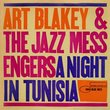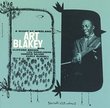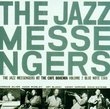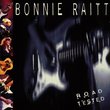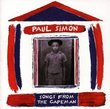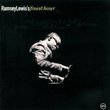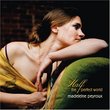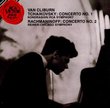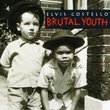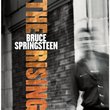| All Artists: Art Blakey & Jazz Messengers Title: At the Cafe Bohemia Members Wishing: 3 Total Copies: 0 Label: Blue Note Records Release Date: 8/7/2001 Album Type: Original recording remastered Genres: Jazz, Pop Style: Bebop Number of Discs: 1 SwapaCD Credits: 1 UPC: 724353214821 |
Search - Art Blakey & Jazz Messengers :: At the Cafe Bohemia
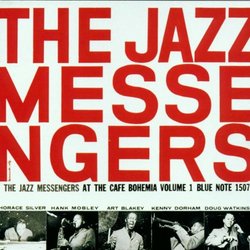 | Art Blakey & Jazz Messengers At the Cafe Bohemia Genres: Jazz, Pop
Although the great drummer Art Blakey took full control of the Messengers soon after, this 1955 live date features the original lineup, the one co-led by pianist Horace Silver. Filled out by trumpeter Kenny Dorham, tenor s... more » |
Larger Image |
CD DetailsSynopsis
Amazon.com Although the great drummer Art Blakey took full control of the Messengers soon after, this 1955 live date features the original lineup, the one co-led by pianist Horace Silver. Filled out by trumpeter Kenny Dorham, tenor saxophonist Hank Mobley, and bassist Doug Watkins, the original Messengers recorded just one studio record (billed as Horace Silver & the Jazz Messengers), which quickly became the standard to beat in hard bop. Volume 1 of the Bohemia records shows them to be a versatile bunch capable of lightning-quick bop workouts, tender ballads, and deep, bluesy grooves. Dorham's trumpet work is especially vibrant; Silver's piano is an unmatched combination of funk and fire, and he also offers some marvelously clever accompaniment. Blakey, of course, steers from behind the skins. After Blakey and Silver split, both led bands that were at the pinnacle of hard bop, so imagine how potent they were when they played together. --Marc Greilsamer Similar CDs
Similarly Requested CDs
|
CD ReviewsA Classic Jazz Messengers Cooking Session! D. Bakken | Minneapolis, MN | 09/04/2003 (5 out of 5 stars) ""Now, ladies and gentleman, I'd like to acquaint you with the Jazz Messengers. On the piano, we have the incomparable Horace Silver. On the bass, all the way from Motor City, ladies and gentleman, one of the youngest and finest bass players in the business today, our bassist, Doug Watkins. And on the tenor saxophone we have a new star on the modern jazz horizon, Hank Mobley. And on the trumpet we have a perennial favorite, he's with the prophet of modern jazz Charlie Parker. He's our arranger, now, and out trumpeter. The uncrowned king, ladies and gentleman, Kenny Dorham."With those words, Art Blakely and the Jazz Messengers begin a two disc jazz classic.Recorded live at the Cafe Bohemia on November 23, 1955Art Blakey - Drums Kenny Dorham - Trumpet Hank Mobley - Tenor Saxophone Horace Silver - Piano Doug Watkins - BassHighly Recommended!" Good "live" early Blakey Bomojaz | South Central PA, USA | 03/20/2005 (4 out of 5 stars) "Here's the first of 2 volumes on Blue Note capturing the Jazz Messengers at the Cafe Bohemia on Nov. 23, 1955. Kenny Dorham, Hank Mobley, Horace Silver, and Doug Watkins join Blakey for the club date. "Prince Albert" is a handsome little tune by trumpeter Dorham, and "Alone together" features tenor saxophonist Mobley in a beautiful ballad performance. "What's new" features Watkins on bass and might be of limited appeal. Volume 1 is slightly better than Volume 2, but you shouldn't have one without the other--and both are very good." Hank and Horace deliver the technical knockout Pharoah S. Wail | Inner Space | 02/09/2009 (4 out of 5 stars) "11/23/55 at the Cafe Bohemia... smoke in the air... glasses clanking... a small crowd of finely tuned listeners hoping to hear something memorable. Kenny Dorham, Hank Mobley, Doug Watkins, Horace Silver and Art Blakey gave it to them!
Early Mobley is so interesting to me. He's not underdeveloped or anything like that, but he's more raw here. Where I tend to think things like "black satin" about his playing and tone on Soul Station or No Room for Squares, here he's more primal. More visceral. This isn't a criticism about one era or the other, just a comment. I love him in everything mentioned, just in different ways, for different reasons. He is awesome here. Unequivocally. Kenny Dorham is in a bit of a development phase here... sometimes. A few times on this album you hear him thinking through his solos. You can sense him intellectually considering the contour of his solo as he's playing. It's not "bad" by any means, but it's not the peak of where you hope to be, as a musician. What did Charlie Parker say? First you learn your instrument. Then you learn the tunes. Then you go out on the bandstand to forget all that Shhht and play! Exactly. Exactly! Kenny wasn't quite THERE yet, at all times here. He was for a couple tracks, though. I'll let you find them for yourself. It's all just flowing out of him. He's not thinking at all. He's just a conduit for the music. Kenny seems to simply open a door and let the music fall out. Those are his peaks of the album. Not enough can be said for the high sonic quality in which this date was recorded. That's certainly a big part of what makes this stuff great. Whether we're comparing this to Complete Jazz at Massey Hall (the best issue of that set) or Live in the World, this kills both of those. The sound here... the musicians' richness of tones comes right through. Only if you were there in the club that night could this music have sounded better. This is one of my favorite albums by one of Blakey's best bands." |

 Track Listings (9) - Disc #1
Track Listings (9) - Disc #1